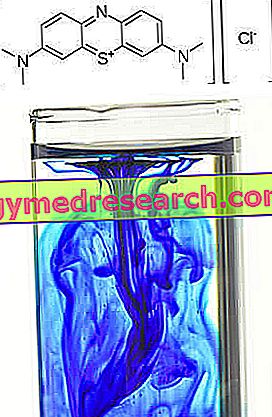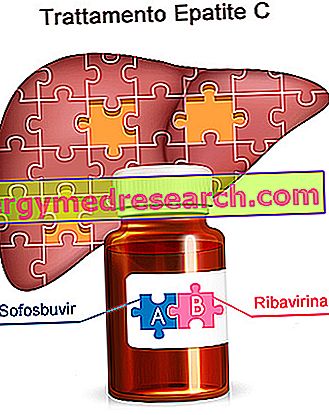Epistaxis and rhinorrhage are the scientific names of a symptom / disorder commonly known as nosebleed.
The epistaxis can be:
- Primary / essential or idiopathic, that is, without an obvious cause
- Secondary (especially in the elderly), when it represents a specific pathological symptom of a local or general problem (even serious).

The main reasons are physical stress (trauma, clumsy maneuvers with the fingers) and hormonal changes in the growth phase.
Some causes of secondary epistaxis are:
- Premises: septal varices, nasal polyps, septum deviations, neoplasms, perforating septal ulcer, Rendu-Osler disease, nasopharyngeal fibroma, chemical irritation from volatile substances or cocaine use, infection (bacterial, viral or fungal rhinitis).
- General: vasal fragility, arteriosclerosis, heart disease, hypertension, infectious diseases (scarlet fever, typhoid fever, measles, etc.), poisoning, coagulopathies, vitamin deficiencies, renal and hepatobiliary diseases, heat stroke.
What to do
- Depending on the cause, the nosebleeds can be prevented more or less effectively (see Prevention).
- Treat or compensate for the diseases that cause bleeding in the nose (dysplasias, ulcers, deviations, varicose veins of the nose; atherosclerosis, heart disease, hypertension, infections, coagulopathies, kidney and liver diseases).
- Follow a balanced diet.
- During the bleeding episode, the most useful measures to stop the bleeding are:
- IF there is no head trauma:
- Acquire a sitting position and tilt your head slightly forward.
- Spit blood to avoid the onset of nausea and vomiting.
- Release the neck: loosen the tie, unfasten the shirt, remove scarf or scarf.
- Apply pressure to the bleeding nostril for a few minutes.
- Apply a cold woolen cloth, better if it contains ice, directly on the nose: the low temperature causes vasoconstriction and the consequent decrease in blood flow. Alternatively it is possible to wet it with cold water.
- IF the epistaxis continues:
- Contact a doctor or a paramedic (first aid) to:
- Application of a pad (cotton or gauze with hydrogen peroxide).
- Nasal cauterization.
- IF the subject loses consciousness it is good to place him lying on his side (in particular with the suspicion of a head injury).
What NOT to do
- Neglecting primary diseases responsible for nosebleeds.
- Avoid exposure to volatile chemicals. Some examples are: thinners, paints, paint remover etc.
- Avoid using cocaine or other inhaled drugs.
- Avoid the abuse of drugs that excessively dry the mucosa or weaken it: antihistamines for allergies, anti-congestants such as naphazoline (eg Rinazina ®), cortisone drugs, etc.
- Avoid the risk of heat stroke, often responsible for nose bleeding.
- During the epistaxis:
- Avoid anxiety and physical agitation: both emotional complications and cardio-respiratory hyperactivity can worsen epistaxis.
- Avoid placing the head backwards: it can favor the ingestion of the blood that comes down from the palate and accumulates in the oral cavity (favoring the onset of nausea and vomiting).
- IF your nose is swollen and painful, making you think of a skull-facial trauma with fracture, AVOID any surgery and contact the emergency room directly.
What to eat
- There is no diet that can prevent nose bleeding. However it is possible to define that a diet rich in vitamins constitutes a preventive factor.
- Plants rich in protective pot substances: they are triterpenes, tannins, pigments etc. They have an antioxidant function and improve collagen synthesis. The foods that contain them are all those of vegetable origin: fruit, vegetables, seeds, roots, flowers, black wine, etc. To preserve their function they must be fresh.
- In case of hypertension, the diet should be aimed at reducing this primary disorder (see Hypertension Remedies).
- If the rhinorrhage is severe and contributes to establishing an anemic picture, it is essential to compensate for the losses by eating foods rich in bio-available iron, vitamin B12, folic acid and vitamin C:
- Foods rich in iron, especially heme and ferrous (2+):
- Muscle tissue: both of terrestrial and aquatic animals: horsemeat, bovine, swine, avian, fish, whole molluscs (also land snails), whole crustaceans etc.
- Eggs: any, especially the yolk.
- Offal and fifth quarter: mainly spleen and liver, but also marrow, diaphragm, heart, etc.
- Foods rich in vitamin C, citric acid and fructose:
- Sweet and sour fruit: lemon, grapefruit, orange, mandarin, clementine, kiwi, cherries, strawberries etc.
- Vegetables and tubers: parsley, pepper, lettuce, spinach, radicchio, broccoli, tomato, potato etc.
- Foods rich in vitamin B12 (cobalamin):
- The same foods source of heme iron; in addition, certain algae and bacteria are rich in vitamin B12.
- Foods rich in folic acid: liver, vegetables (eg tomatoes), sweet fruit (orange, apple, etc.) and legumes (eg beans).
- NB : Vitamin C or ascorbic acid and folic acid are thermolabile molecules and degrade with cooking. This means that the foods that contain them must be eaten largely raw.
- However, the anti-nutritional principles (phytates and oxalates) are degraded by heat treatment. This means that legumes, whole grains, spinach, rhubarb etc should always be consumed after cooking.
What NOT to Eat
- There are no foods that worsen the bleeding of the nose, except for alcoholic beverages and chili peppers, which exert a marked dilating vase effect.
Natural Cures and Remedies
- Herbalism. It is based on vegetables rich in tannins, triterpenes, flavonoids in general and vitamin C. They optimize collagen synthesis by strengthening the vessels and acting as powerful antioxidants:
- Shepherd's purse.
- Bistorta.
- Comfrey.
- Oak mistletoe.
- Nettle.
- Horsetail.
- Tormentilla.
- Goldenseal.
- Witch Hazel.
- Centella asiatica.
- Ivy.
- Hesperidin.
- Diosmin.
- Horse chestnut.
- Rusco.
- Rutin.
- Escina.
- Blueberry.
- Red grapevine.
- Vitamin C food supplements: optimize collagen synthesis.
- Supplements based on arginine: essential amino acid precursor of nitric oxide, an essential compound for vessel elasticity.
Pharmacological care
- Witch hazel-based ointment (plant): it is indicated in the treatment of epistaxis, but it is not a real drug
- Tranexamic acid, for example Ugurol® and Tranex®: are anti-hemorrhagic drugs that facilitate coagulation and reduce bleeding from the nose. They are used only in cases where rhinorrhage is very serious and associated with the general bleeding tendency.
Prevention
The preventive measures against rhinorrhage are generic and mainly concern cases of primary epistaxis:
- Avoid pressure fluctuations: a striking example is that of the fleeting ascent of a scuba diver. On the other hand, such conduct could lead to far more serious complications than a trivial bleeding of the nose (see Decompression Disease - MDD).
- Monitor any diseases that cause bleeding from the nose and avoid relapses; especially colds, allergic rhinitis, the flu and in general all the diseases that affect the nose. They determine the inflammation / hypertrophy of the mucous membranes and their irritation, consequent to repeatedly blowing the nose.
- Do not expose the nasal mucous membranes to volatile irritants.
- Do not use drugs nasally unnecessarily.
- Do not expose the nasal mucous membranes to physical stress.
- Preventing heat stroke.
- Follow a balanced diet, rich in vitamins and other nutritional elements that can improve the condition of the vessels.
Medical Treatments
- Application of a cotton swab or hydrophobic gauze inside the nostril: this is an operation that should be performed by medical or paramedical personnel. However, if the blood from the nose is not complicated by bone fractures, lacerations of the mucosa and loss of consciousness, it is possible to perform the maneuver independently.
- Nasal cauterization or galvanocaustification: mucosal burning operation in which the vessel has broken. It serves to heal the lesion by stopping the bleeding. It must be performed by medical personnel.
- Ligation: consists of manual locking with a strand of the damaged vessel.



